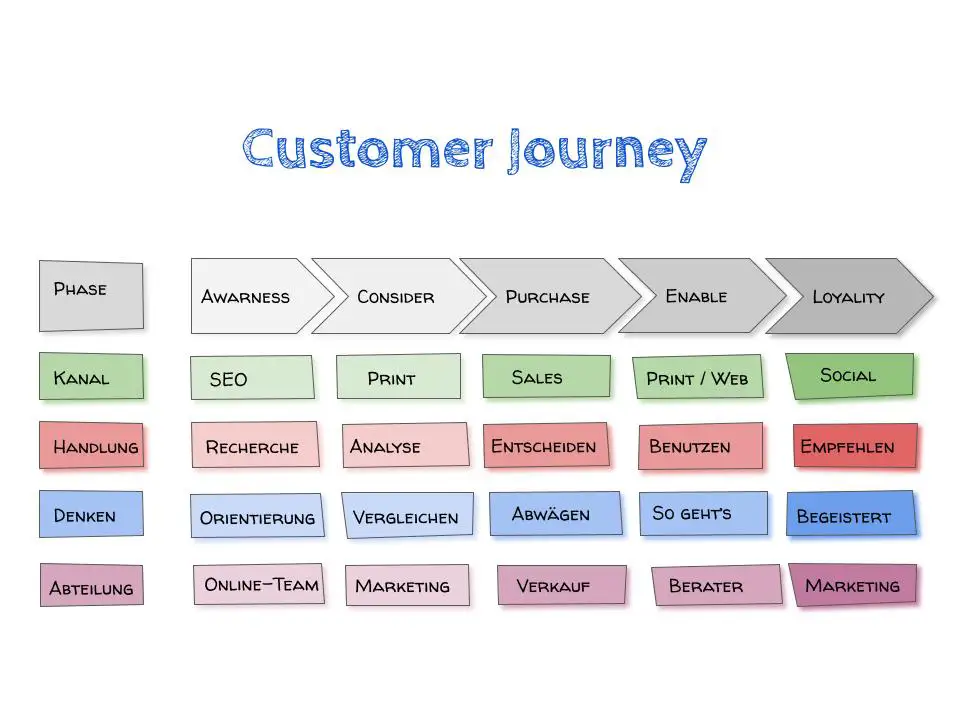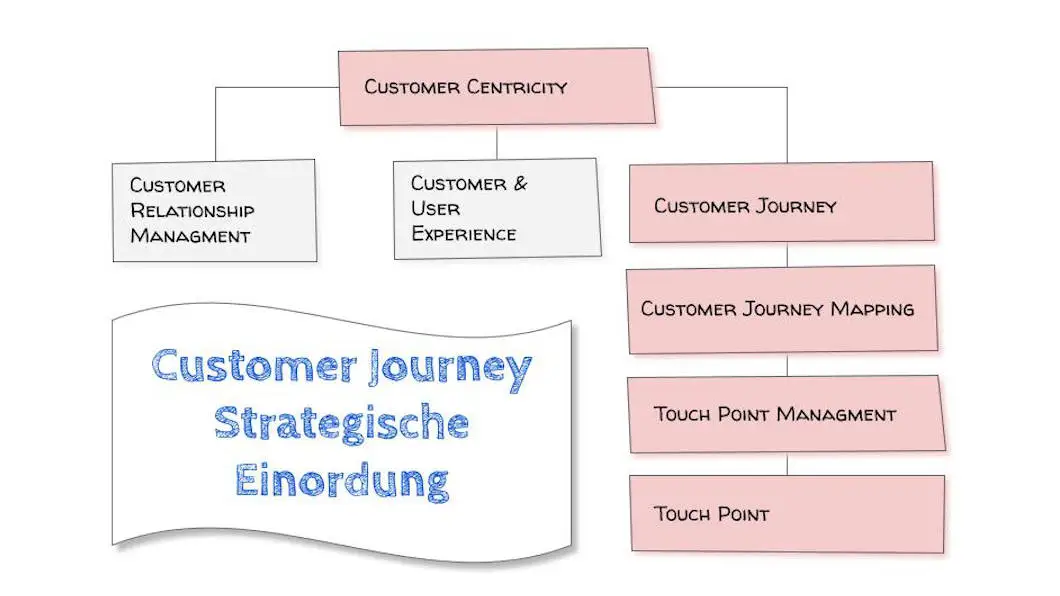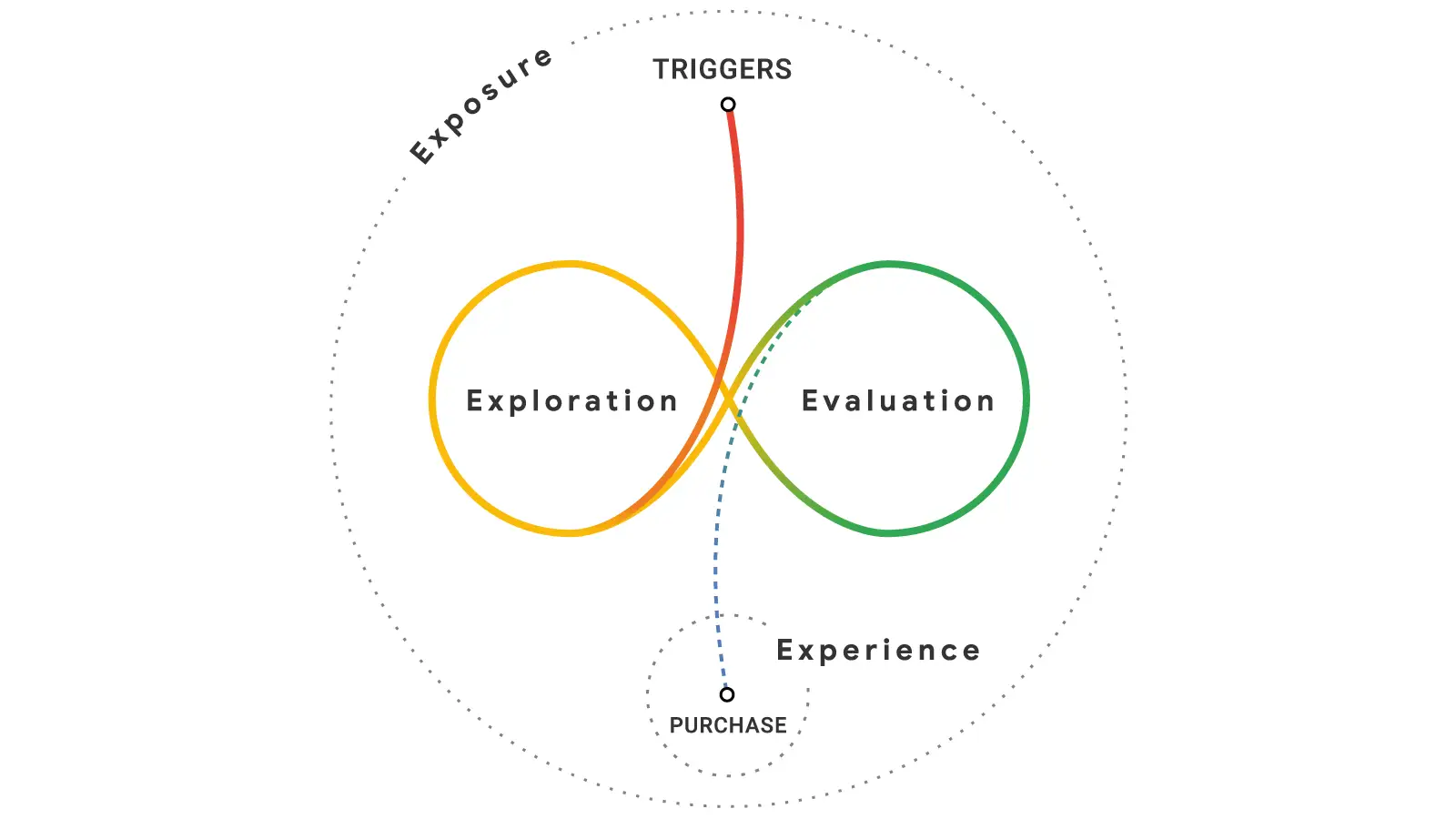
The customer journey as a strategic tool
The digital transformation is opening up more and more channels through which customers move. Quality requirements are also constantly increasing. With a consistent strategic focus on customer needs, companies can fulfill their customers’ expectations at a high level and thus offer exceptional customer experiences.
The customer journey can be used as a tool to better understand customers and offer them a perfect path through the entire customer contact journey.
The benefits of a customer journey for your company:
Customer journey mapping, the graphical representation of the customer journey with its touchpoints, shows a customer’s path from the first contact to a returning customer. The customer journey map can almost be seen as a balanced scorecard for companies.
- Comprehensive understanding of your own customers
- Improved process-related and emotional customer experience
- Every step means an improvement
- Improved user and customer experience (UX/CX)
Strategic classification
How can companies consistently align their activities with the customer so that the customer is at the center of the company’s activities?
The customer journey as a sub-construct under the term customer centricity is crucial for understanding customer satisfaction. Over the course of time, countless touchpoints, channels and media have developed in communication between companies and customers. Customers also use social media to interact with each other and share experiences. This requires companies across all departments to create positive customer experiences along the customer journey through to the sale and beyond.
Customer centricity – the customer is king
In order to classify the term customer journey, we will first clarify the terms and categorize them. Customer centricity is the consistent organizational focus of companies on customer needs and customer satisfaction. The main focus here is on the company organization across all management levels with functional and relationship-building competencies. Based on different approaches to defining customer centricity, research (Kalka and Abel, 2018) clearly shows that three management constructs are repeatedly included:
- Customer Relationship Management (CRM)
- Customer Journey Management (CJM)
- Customer Experience Management (CEM)

Customer Relationship Management – more than just addresses
The economic management of customer relationships is becoming increasingly important. Integration into marketing and sales processes, as well as the mapping of targets and the management of resources, are becoming increasingly important for companies. The aim is to achieve a holistic view of the company in terms of its processing and relationship with its customers.
According to Duden, customer relationship management is the “entirety of strategies and measures for establishing and maintaining customer loyalty”. Communication, distribution and offer policies must be integrally aligned with customer needs. Customer satisfaction as a measure and indicator of customer loyalty represents a long-term value for your company.
Customer Experience
“What people really desire are not products but satisfying experiences” (Lawrence Abbott, 1955)
The customer experience can be defined as the sum of all reactions and experiences of a person to a company during the pre-purchase, purchase and post-purchase phases. The respective reaction serves as a trigger or comparison value for a next phase.
Customer experience (CX) and user experience (UX) are often used as synonyms. There is a considerable difference between these terms. UX is multi-layered and can be described as definition, understanding and communication. UX is divided into the definition phase of products and processes, their understanding and the corresponding communication, and deals with all processes before and after.
This is where the customer experience goes one step further. All touch points (interfaces) between the customer and the company are managed and brought together. Compared to UX, CX also includes the company’s internal processes. It is therefore a process to build the customer experience in the following steps:
- Analysis of the world of experience
- Development of the experience platform
- Design of the brand experience
- Structure of the customer experience
- Continuous improvement and innovation
From a practical perspective, this can be seen as the corporate culture in relation to customer experiences, the strategic orientation for the design of customer experiences and the corporate capability for the constant renewal of customer experiences with the aim of generating and maintaining long-term customer loyalty.
Customer Journey
We use the term customer journey, although a prospective customer or lead is only a customer once they have made a purchase. The customer journey is a complex, non-linear system. It is a path or sequence that a customer uses to reach their goal and satisfy a need. As a company, this path should now be as customer-centric as possible.
The customer journey is therefore the contact route that a customer follows via a sequence of contact points with the company in order to carry out a predefined target action (conversion).
Customer journey mapping
Customer journey mapping is the inventory of current processes and services along the customer journey. It is the basis for mapping the customer journey and supplementing it with further analyses.
Touchpoint Management
Touchpoints (customer touchpoints) are the numerous possible points of contact between customers and a company. Touchpoint management describes measures taken by companies across all touchpoints to offer customers the most positive experience possible. The aim is to optimize purchasing and decision-making processes, strengthen existing customer relationships and acquire new customers. Touchpoints are one of the central aspects of service design. They also offer the opportunity to create a difference from similar products and services and thus present a uniqueness.
Customer journey models
Marketing strategies and models have evolved over time and adapted to the current state of research and technology. Below are just some of the models over time to illustrate this:
| AIDA | 1898 | Elias St. Elmo Lewis |
| DAGMAR (sales funnel) | 1961 | Colley |
| 5 A’s | 2017 | Kottler, Kartajaya, Setiawan |
| Moments of Truth |
2005 2006 2011 |
Lafley (Proctor & Gamble) Blackshaw Lecinski (Google) |
| Customer Decision Journey | 2009 | Court (McKinsey) |
Customer journeys can be represented in different models. Models are an abstraction of the original and are used when there are functional and behavioral similarities to the original, but the implementation on the original is too complex.
All customer journey models basically contain the three phases of pre-purchase, purchase and post-purchase. A pre-purchase phase, which includes purchase preparation, describes the customer’s interaction with the brand. The identification of a need, the search for a solution and the impulse to satisfy this need with a purchase. The purchase phase comprises all customer interactions relating to the purchase event. This includes, among other things, the specific selection of the product, ordering, delivery options and payment. The post-purchase phase comprises the customer’s interactions with the company and the product or service, which become the dominant touchpoint here. The experience gained in the post-purchase phase can be a trigger for a new purchase.
There are also models that further subdivide the three phases. Depending on the model, the pre-purchase phase is further divided into a pre-awareness, awareness, consideration and preference phase. The post-purchase phase can also be further segmented. After sales and loyalty are mentioned here. (
Aufgesang, Olaf Kopp
)
In addition to spas, which are regularly mentioned, other terms are also used to describe the phases. These describe the customer’s action or activity in the corresponding phase: search, information, purchase, use/service and repurchase.
AIDA (Attention, Interest, Desire, Action)
The AIDA model is divided into four phases. The customer is indicated by the four levels by means of behavioral influence. Advertising triggers attention and is intended to arouse motivation (interest). Desire should lead the customer to purchase (action). There are also more advanced models based on the AIDA formula. Sukma Wijaya (2012) presented the “AISDALSLove” model, which includes the phases Attention, Interest, Search, Desire, Action, Like/dislike, Share, and Love/hate.
Sales funnel or sales funnel
Sales funnel models describe the mental states of customers in the phases that lead to a purchase. The phases are Awarness, Interest, Consideration, Intent, Evaluation and Purchase. This model is also known as the DAGMAR model (Colley, 1961). This acronym stands for “Define Advertising Goalsfor Measuring Advertising Results“. Furthermore, the model of Howard & Sheth, (1969) is attributed to the sales funnel. The sales funnel model is also viewed critically. “There is simply no empirical evidence for the model. As far as I can tell, no one has ever been able to prove a phase sequence as postulated by the sales funnel models” (Rutschmann, 2018).
Customer Decision Journey according to McKinsey
Based on an AIDA-like model with the phases Awarness, Familiarity, Consideration, Purchase and Loaylity, McKinsey conducted a study in 2009 with almost 20,000 consumers in five industries and three continents.
The study showed a shift from one-way communication between customers and companies to a dialog. Companies need tools to satisfy customer needs and shape the customer experience. The four phases are divided into Initial Consideration, Active Evaluation, Purchase and Postpurchase Experience. It was observed that two thirds of the touchpoints in the active evaluation phase were influenced by internet research and word-of-mouth recommendations.
The
Customer Decision Journey Model from McKinsey
also differs from the usual models in its graphical representation. It is displayed in two loops. The outer phase represents the first pass through all phases for an initial purchase. The loyalty loop represents customer loyalty that can be actively managed.

Moments of Truth
The expression “Moment of Truth” goes back to Jan Carlzon, Scandinavian Airlines.
In 2005, Lafley, CEO of Procter & Gamble, coined the first two “Moments of Truth”.
- “The first moment of truth (FMOT) is when the customer looks at a product. This can be in-store or online”.
- “The second moment of truth (SMOT) is when the customer actually buys the product and uses it”.
A third was added later. Pete Blackshaw, who also worked at Procter & Gamble, is often associated with this.
- “The third moment of truth (TMOT) is when customers give feedback about the product. They share it with the company as well as with their friends, colleagues, family members, etc.”
In 2011, the Zero Moment of Truth (ZMOT) was introduced by Jim Lecinski (Google). Triggered by a stimulus such as advertising, the customer starts researching on the Internet. This involves searching for further information.
- “ZMOT is that moment when you grab your laptop, cell phone or other wired device and start researching a product or service (or a potential friend) you want to try or buy. I’m sure you know what I mean – you probably do web “searches” like this every day.
The Ultimate Moment of Truth (UMOT) was introduced by Brian Solis in 2013 and describes the step after the purchase when the customer reports on their experience with the product or service (Solis, 2019). This UMOT is therefore critical, as companies can only control this moment to a limited extent and critical voices can also be raised about the object of purchase.
- “Ultimate Moment of Truth, is the moment when people turn an experience into discoverable content and publish it on one of the countless social platforms people use today to stay connected. In this networked economy, the UMOT becomes the next person’s Zero Moment of Truth, over and over again.”

Further customer journey models
Based on the models mentioned above, there are many more. They differ in the depth of the phases, characteristics of technologies or are mixed models. For example, the Customer Purchase Journey model by Aldo Cundari, which combines the MOT model with the Decision Journey model and divides the phases into Awareness, Consideration, Evaluation, Purchase and Experience. Cundari places the ZMOT between the consideration and the evaluation. The purchase phase is attributed to the FMOT.
Customer journey mapping
A customer journey map is basically a diagram that graphically depicts the customer’s contact path through the pre-purchase, purchase and post-purchase phases. The more contact points such a diagram contains, the more necessary the customer journey map can become.
The customer journey mapping process is intended to provide a holistic view of the customer contact journey. The two tools of storytelling and visualization should prepare information in such a way that a clear journey map is created that shows all levels of consideration of the specific business model in relation to the customer. A five-step procedure is proposed:
- Collecting internal findings
- Developing initial hypotheses
- Researching customer processes, needs and perceptions
- Analyzing customer research
- Mapping the customer journey
Another option is to analyze touchpoints, goals, journeys and experiences.
Customer journey mapping should be seen as a constant process that adapts to changing habits and changing situational conditions in the market environment.
Touchpoints
Touchpoints as a point of contact or contact between customers and companies are of great importance. After all, these are the points at which people come into contact with companies and brands. There are touchpoints that can be controlled by companies and those that cannot, indirectly or hardly at all.
| Controllable / influenceable touchpoints | Touchpoints that are not or hardly controllable |
|---|---|
| Classic advertising (advertisements, TV or radio commercials, direct mail, PR, etc.) |
Partners, friends and acquaintances (Word of Mouth) |
| Trade fairs & events | Personal social media network |
| Search engine optimization | Editorial reporting |
| Search engine advertising | Forums & Blogs |
| E-mail marketing | Rating portals |
| Website /Webshop | |
| Sales outlet / sales staff |
Graphical representation
The table format is suitable for presenting the customer journey graphically. Typically, the process progress of the phases is dominant. This allows the possible channels, advertising media, content and advertising media to be categorized into the individual phases of the customer. The graphical representation should be adapted to the respective customer contact route, target group and other parameters of the model. A customer journey for a children’s chocolate ice cream will look different from one for a nuclear power plant.

It should be borne in mind that customers’ real purchasing decisions are not as linear as described in the models. The way in which purchasing decisions are made is becoming increasingly confusing due to the complicated network of touchpoints. The growth of touchpoints via the Internet and the ability to search for and compare products and services are resulting in a changing dynamic. This leads to consumers reacting to the almost inexhaustible information with preconceived prejudices and preconceptions. Searching for information and weighing up the options are two different mental modes. This results in a messy middle:
The search, an expansive activity, and evaluation, a reductive activity. One of these two mental modes is always active over long stretches of the customer journey and is repeated for as long as is necessary for the personal purchase decision.

Part 2: Customer journey mapping – a guide to your own customer journey
So how should you go about creating a customer journey map in your own company? The aim of the customer journey is to improve the customer experience and thus offer the customer a positive experience when interacting with the company. The following should be considered:“The customer journey is a very simple method: you put yourself in the customer’s shoes and visualize processes or services from their perspective. However, it will not be possible to fully implement the customer’s view, as it will always be colored by the customer’s own assumptions. Customers think differently” (Johannes Robier, 2006).Before starting with the presentation of the customer journey map, the target group should be defined. This can be done via customer profiles, customer segments, typology or personas …..
Customer journey mapping
Part 2 The “Guide to your own customer journey” will be published soon. If you subscribe to our newsletter, you will be informed automatically. It is worth it.
* Mandatory fields
Information on data protection, revocation, logging and the performance measurement covered by the consent can be found in our data protection declaration

Frank Huber
044 289 89 12
